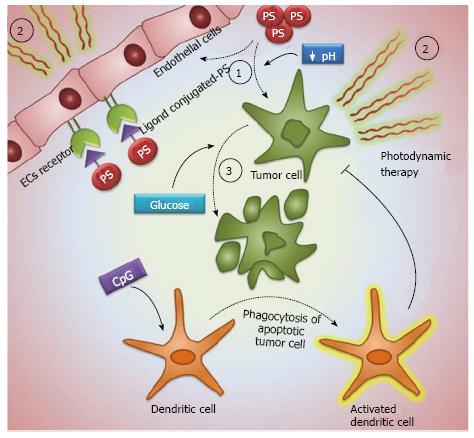Copyright
©2014 Baishideng Publishing Group Inc.
World J Clin Oncol. Dec 10, 2014; 5(5): 901-907
Published online Dec 10, 2014. doi: 10.5306/wjco.v5.i5.901
Published online Dec 10, 2014. doi: 10.5306/wjco.v5.i5.901
Figure 1 Photodynamic therapy (PDT) combined with tumor microenvironment intervention on breast cancer.
PDT is one of the alternative methods for breast cancer treatment and involves: (1) administration of a photosensitizer (PS), which is internalized into either tumor cells or surrounding vasculature; (2) local irradiation at a wavelength corresponding to the absorbance peak of the PS; and (3) light activation of the PS, which promotes cell death mainly by apoptosis. Because of the benefits of improving PDT outcome, researchers have developed strategies to target the vasculature surrounding breast tumor cells by conjugating the PS with endothelial cell (EC)-specific ligands. Immunoactivation of dendritic cells using CpG increases phagocytosis of PDT-killed tumor cells and leads to their maturation and activation, thereby promoting an antitumor immune response. Regarding abiotic environmental factors, it was shown that photodynamic therapy sensitivity is reduced in glucose-deprived cells, and that a lower extracellular pH leads to increased PS uptake, reinforcing the photodynamic response.
- Citation: Lamberti MJ, Vittar NBR, Rivarola VA. Breast cancer as photodynamic therapy target: Enhanced therapeutic efficiency by overview of tumor complexity. World J Clin Oncol 2014; 5(5): 901-907
- URL: https://www.wjgnet.com/2218-4333/full/v5/i5/901.htm
- DOI: https://dx.doi.org/10.5306/wjco.v5.i5.901









